oldmanwilly
Gold Member
- Joined
- Mar 7, 2014
- Messages
- 4,051
The BladeForums.com 2024 Traditional Knife is available! Price is $250 ea (shipped within CONUS).
Order here: https://www.bladeforums.com/help/2024-traditional/
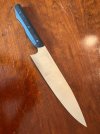
Since it is an oxide that forms it would qualify under most definitions of corrosion. However, the black oxide is different than rust. The biggest problem with rust is that it flakes away and the corrosion continues. So the performance of the knife would not be affected but the customer would have to decide if the appearance has been negatively affected. However, corrosion protection of stainless steel also occurs due to oxide formation, in that case a chromium oxide. Titanium and aluminum form their own invisible surface oxides which suppress further corrosion. The formation of that oxide layer is not typically called “corrosion” though it fits the definition.Can we really call surface oxidation corrosion? Corrosion sounds like it implies actual degradation of the material. That's why I said leave the knife wet for a few days, and I doubt it will rust, by which I meant the type of oxidation that eats steel and degrades edges, rather than colors a few molecules thick layer of the surface.
most likely it had cross contamination from machining between their different models.Interesting. On a side note, I have a "stainless" revolver, that started rusting quite a bit, even though I maintained it well. I sent it back to S&W that blasted and re-passivated it (where I learned the term - seems to be routine for guns). No problem since then. Don't know of any knife maker who does it though.
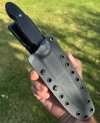
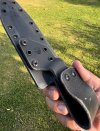
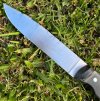
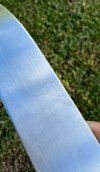
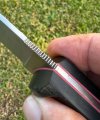

Yes sir!^^^ that sheath (from Al ?) is holding up really well, too !
Was that the Na Pali coast?Last week it was on my belt for six days while staying in a place only accessible by boat or helicopter.
Close! That coastline is also incredibly beautiful.Was that the Na Pali coast?
That rig really appeals to me, as a trusted tool that has seen hard use, including the sheath.
I remember when you originally posted about that knife. I'm glad to see it's still serving you well in paradise.Here is a very nice custom thatRichard338 made and gifted me. His orders were to use it hard, and I am enjoying it a lot.
I use it for everything, including riding on my belt when spear fishing in the Pacific, and prawn diving in a river. It also served kitchen duty, cutting wood for stakes, trimming back jungle trails, etc.
Last week it was on my belt for six days while staying in a place only accessible by boat or helicopter.
It does stain a bit. But the edge remains crispy and no rust.View attachment 2638389View attachment 2638390
View attachment 2638391View attachment 2638392View attachment 2638393View attachment 2638405
It's design ticks a lot of boxes for how I use a hip knife, that's for sure!I remember when you originally posted about that knife. I'm glad to see it's still serving you well in paradise.
That is the stinger description for Google, you missed the “Is it a success?” question that followed. Meaning the reader is invited to read the article and come to his own conclusions. Of course it does not say or imply that the corrosion resistance is better than any other steel. The corrosion resistance is better than many other knife steels as I showed with the testing in the article.
you haven't used anything that would remove a light patina. You need an abrasive, like a polish. The flitz suggsted above is what I use when I need a light abrasive.
As promised, proof and pudding (or however that saying goes).

light patina only showed up after cutting raw, red meat.
Your post, like your article, doesn't mention staining. Testing for stain resistance on a stainless steel, not just corrosion resistance etc.
The problem isn't removing the stain once, it's getting stained after food prep / meals and having to deal with that every time I use it, which is every day...with chemicals. It's a problem I never had before with any steel.
And mine's a skinner....
It's not just raw meat though, it's also cooked. I bought a Magnacut skinner so I can easily prepare meat, and eat meat, and easily wash without transferring material or 'patina'. On that end, it failed completely. It's a reality I would have liked to known before purchasing.
As I already explained, staining is a form of corrosion. That’s why corrosion-resistant steel is called “stainless.” In my corrosion testing I did not observe staining hence why it was not mentioned in the article. Corrosion tests by other people have been reported online where staining was not found with various knives so it is not only me.Your post, like your article, doesn't mention staining. Testing for stain resistance on a stainless steel, not just corrosion resistance etc.
the real question is whether the knives that develop patina have "contaminated" Magnacut: as in, are the contaminants being discolored or is the steel being discolored? I tend to think the former is the answer.
which knife of yours is problematic? Was it a Viper?
In my corrosion testing I did not observe staining hence why it was not mentioned in the article.
I have no dog in this fight, but I do really like the MagnaCut knives I have. Mine have not shown any signs of corrosion and the reason I wanted MagnaCut was specifically for some of the conditions I am in. It also keeps an edge a long time and takes very little effort stropping it back to hair popping sharp.But you only used salt-water to test for rust resistance. You didn't use meat, blood, etc to test for stain resistance. There are those here (and elsewhere) who did, and have shown Magnacut can have an extremely low resistance to staining.
